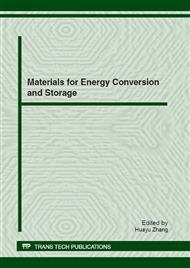p.45
p.49
p.53
p.57
p.61
p.65
p.70
p.74
p.79
Synthesis of Nest-Like NiO and its Application on P-Type Dye-Sensitized Solar Cell
Abstract:
The nest-like NiO was successfully prepared by calcining the Ni(OH)2 precursor synthesized using wet chemical deposition method. A NiO-based p-type dye-sensitized solar cell was fabricated. The photocathode films were coated by doctor-blading NiO paste onto the FTO substrates. The thickness of NiO film was controlled by repeatedly blade coating using one layer of tape. The results manifested that the thickness of the NiO film significantly influenced the photoconversion efficiency. The solar cell based on the NiO film with 13 μm thickness showed the highest photoconversion efficiency. In addition, the influence of the dye is also investigated. The NiO films were sensitized with C343, N3, and Z907, respectively. The measurement of photocurrent density-voltage characteristics indicated that the highest photoconversion efficiency is about 0.027% using C343 sensitized.
Info:
Periodical:
Pages:
61-64
Citation:
Online since:
July 2012
Authors:
Price:
Сopyright:
© 2012 Trans Tech Publications Ltd. All Rights Reserved
Share:
Citation:



